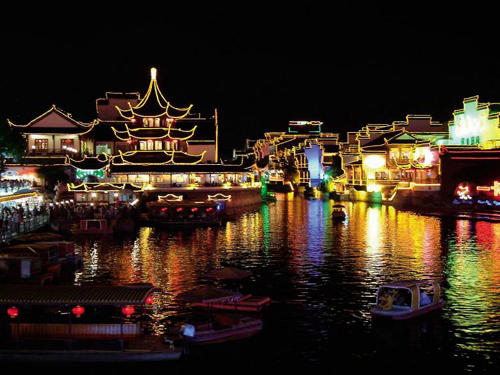『Nanjing and Suzhou』
NanJing
Known as Jinling in old days,
Nanjing is the capital city of Jiangsu province. Strategically situated
on the Yangtze river, with a moist climate, its terrain rendered majesty
by the mountains in the background, it is also the province’s
political, economic, cultural andtransportation center.Nanjing today
looks not only new but also old:New due to the ongoing
modernization drive, and old because it is already 2,460 years old. As
one of seven ancient capitals in chinese history, Najing was the capital
city for 10 feudal dynasties.

SuZhou
SuZhou, located in the Taihu lake
basin, which is the most prosperous part of the Yangtze river delta, and
199km east of shanghai, is a famous cultural city with a history of
more than 2,500 years. Rising simultaneously with the city itself were a
venice-like layout with tiny bridges sitting gracefully on rivulets and
streams which ran parallel with the streets.
SuZhou is celebrated for its many
classical gardens, and the unesco has endorsed some of them as world
cultural heritage sites. The suburbs of suzhou are studded with ancient
waterfront towns –zhouzhuang, tongli and luzhi are three of the most
prestigious ones.

QinHuai River Scenic Belt
The Qinhuai river, about 100 km is a sub-branch of Yangtze river, as
well as a famed scenic belt in Nanjing. The inner section of the river
used to be the most prosperous place of nanjing: painted boats shuttled
to and fro and music sounded all night. From there many love affairs and
romantic stories spread. Having been archaized and revived, nowadays,
the region becomes the most characterized area for commerce, tourism and
folklores. Night cruse on the river and visiting the night fair are
unique tourist programs available for visitors to Nanjing.

Sun Yatsen Mausoleum
The mausoleum for dr, sun yatsen(1866-1925), forerunner of chinese
democratic revolution, was built during the 1926-1929 period. it takes
an area of 80,000 square meters, and the entire layout looks like a
giant bell tower screened by green forest.

SuZhou Gardens
Beginning from the song, construction of private landscape gardens and courtyard houses came in vogue among local scholar-gentry, so much so that for a time the city had as many as 270 such gardens. Aloofness from the den and traffic of the outside world was what was on the minds of owners of these gardens, in which limited space was cunningly arranged to engender scenic spots that allowed owners to have nature all to himself without stepping out of the city. in 1997, the UNESCO put Humble Administrators Garden, the Lingering Garden and Circular-grace Mountain Villa on its world cultural heritage site list. Humble Administrator’s Aarden and Fishing-net Master’s Garden are open at night so that visitors can attend theatrical performances and enjoy the night scenery.

